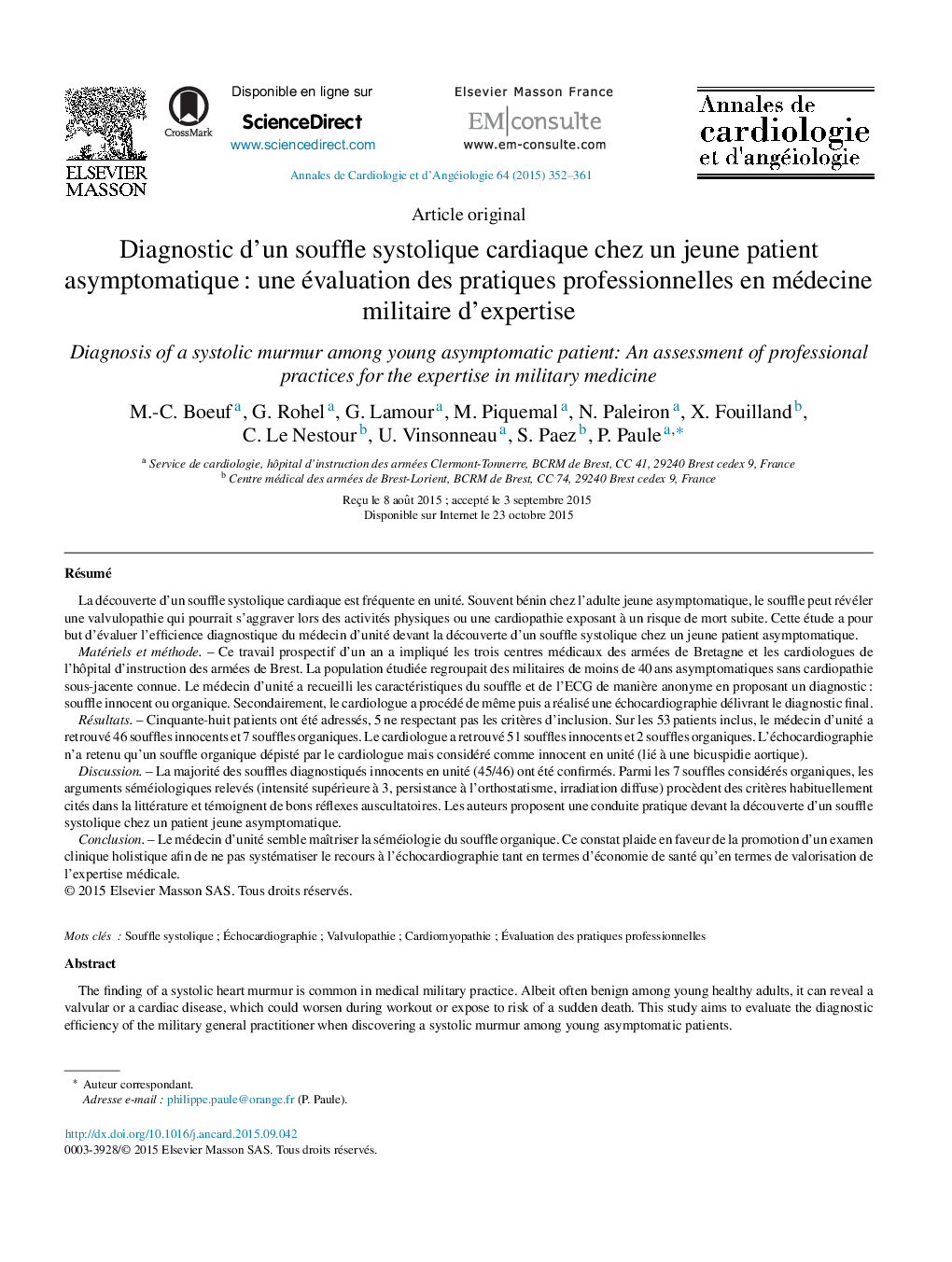| Article ID | Journal | Published Year | Pages | File Type |
|---|---|---|---|---|
| 2868452 | Annales de Cardiologie et d'Angéiologie | 2015 | 10 Pages |
RésuméLa découverte d’un souffle systolique cardiaque est fréquente en unité. Souvent bénin chez l’adulte jeune asymptomatique, le souffle peut révéler une valvulopathie qui pourrait s’aggraver lors des activités physiques ou une cardiopathie exposant à un risque de mort subite. Cette étude a pour but d’évaluer l’efficience diagnostique du médecin d’unité devant la découverte d’un souffle systolique chez un jeune patient asymptomatique.Matériels et méthodeCe travail prospectif d’un an a impliqué les trois centres médicaux des armées de Bretagne et les cardiologues de l’hôpital d’instruction des armées de Brest. La population étudiée regroupait des militaires de moins de 40 ans asymptomatiques sans cardiopathie sous-jacente connue. Le médecin d’unité a recueilli les caractéristiques du souffle et de l’ECG de manière anonyme en proposant un diagnostic : souffle innocent ou organique. Secondairement, le cardiologue a procédé de même puis a réalisé une échocardiographie délivrant le diagnostic final.RésultatsCinquante-huit patients ont été adressés, 5 ne respectant pas les critères d’inclusion. Sur les 53 patients inclus, le médecin d’unité a retrouvé 46 souffles innocents et 7 souffles organiques. Le cardiologue a retrouvé 51 souffles innocents et 2 souffles organiques. L’échocardiographie n’a retenu qu’un souffle organique dépisté par le cardiologue mais considéré comme innocent en unité (lié à une bicuspidie aortique).DiscussionLa majorité des souffles diagnostiqués innocents en unité (45/46) ont été confirmés. Parmi les 7 souffles considérés organiques, les arguments séméiologiques relevés (intensité supérieure à 3, persistance à l’orthostatisme, irradiation diffuse) procèdent des critères habituellement cités dans la littérature et témoignent de bons réflexes auscultatoires. Les auteurs proposent une conduite pratique devant la découverte d’un souffle systolique chez un patient jeune asymptomatique.ConclusionLe médecin d’unité semble maîtriser la séméiologie du souffle organique. Ce constat plaide en faveur de la promotion d’un examen clinique holistique afin de ne pas systématiser le recours à l’échocardiographie tant en termes d’économie de santé qu’en termes de valorisation de l’expertise médicale.
The finding of a systolic heart murmur is common in medical military practice. Albeit often benign among young healthy adults, it can reveal a valvular or a cardiac disease, which could worsen during workout or expose to risk of a sudden death. This study aims to evaluate the diagnostic efficiency of the military general practitioner when discovering a systolic murmur among young asymptomatic patients.Materials and methodsDuring one year, this study involved all the general practitioners of the medical military centres of Brittany and the cardiologists of the military hospital in Brest. It prospectively enrolled a cohort of all military asymptomatic patients under 40, without any underlying known heart condition. Military general practitioners listed, thanks to an anonymous form, the main features of the systolic murmur and of the ECG and proposed an auscultatory diagnosis: innocent or organic murmur. Then cardiologists did the same and finally performed a transthoracic echocardiography giving the diagnosis.ResultsFifty-eight patients were referred, 5 not meeting the inclusion criteria. Of the 53 patients included, military general practitioners found 46 innocent murmurs and 7 organic ones. Cardiologists found 51 innocent murmurs and 2 organic. Transthoracic echocardiography just took on one organic murmur (linked with a bicuspid aortic valve), spotted by the specialist, though judged innocent by the general practitioner.DiscussionMost of innocent murmurs diagnosed by general practitioners (45/46) were confirmed. Regarding the seven organic murmurs, the main selected criteria (intensity over 3, orthostatic persistence, diffuse irradiation) are mostly in accordance with the literature, proving right medical instincts. Authors propose a practical management of systolic murmurs among asymptomatic young patients.ConclusionMilitary general practitioners seem to master symptoms of organic murmur. This assessment argues for a promotion of a holistic clinical examination, which will help not only to rationalize the use of transthoracic echocardiography in economic terms but also to value the medical expertise.
